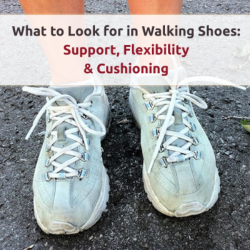Because your feet are unique to you, selecting a pair of walking shoes has to be based on what fits your feet the best and not based on looks, reviews or price. The most expensive shoe might not be your best choice.
If you are unsure of what to look for in a good pair of walking shoes, seek advice from a knowledgeable shoe representative in a sports store. They tend to have more experience fitting athletes with the proper footwear.
Features for Good Fitting Walking Shoes
When selecting shoes, look for a pair that gives you right amount of support, flexibility and cushioning.
- Support – A shoe right for your foot should fit your foot snugly, but not so tight that it compresses your foot. If your shoe fits too loosely, it can cause blisters and even damage your toenails, if they jam against the front of the shoe. Remember your feet swell during exercising, so you may need a size bigger than what you wear in other shoes.
- Flexibility – Walking shoes that fit right should bend where your foot naturally bends. If the sole is too stiff, you can end up with foot pain.
- Cushioning – Even though walking is a low impact sport, you want cushioning in the sole. It cushions your heel when it strikes the ground and improves the fit of the shoe.
Always try on shoes before buying. If you plan on buying shoes online, go to a shoe store first and try on the same pair you plan on buying to ensure a good fit.
Also, if you have stride problems, such as overpronation (where your foot rolls too far inward with each step) or fallen arches, make sure your shoe or insole compensates for it. Some manufacturers use motion control technology that compensates for overpronation. In some cases it may be necessary to get a custom pair of orthotics made for your shoes.
Determine Your Foot Wear Pattern on Your Walking Shoes
When shopping for new shoes, bring an old pair of walking shoes with you. The wear pattern on the sole will help the salesman recommend new pairs of shoes that will complement your feet and even improve your walking.
Replacing Your Walking Shoes
If you walk a lot, plan on replacing your shoes at least once or twice a year. When you walk, the outside portion of your heel hits the ground first, as your step progresses, the weight on your foot shifts forward and in towards your arch, As your step finishes, the weight shifts forward to the ball of your foot and you push off for your next step with your toes.
The continuous movement of your feet eventually breaks down the cushioning and arch support on the inside of your shoes. If you start to have sore feet, check your walking shoes as it may be time to replace them.
If you’d like to get more out of your walking for fitness plan, check out the “Guide to Setting Your Walking Fitness Goals” for more in depth knowledge on the subject of walking for fitness. While you’re there, be sure to sign up for the free MyFitnessNut.com Newsletter to be kept up to date on the latest health and fitness topics.
